
“Every hard work deserves a relaxing ending.” Physically, your long work, training, or performance periods should earn a well-deserved and revitalizing break. Foam Rolling Glutes is a great way to recover from muscle tension and soreness. It is a self-myofascial release (SMR) method that utilizes a foam roller to exert pressure and massage sore muscles that are difficult to reach without assistance. This relaxing method provides instant ease and comfort to achy tight spots, giving you satisfying self-care after a tiring day.
Benefits of Foam Roller Exercises
1. Reduced Muscle Soreness
Foam rolling, a form of self-myofascial release (SMR), reduces muscle soreness by breaking up adhesions and increasing blood flow. Due to waste buildup and microtrauma, physical activity can create knots, tight fascia, and tension. Applying pressure with a foam roller certainly helps relax and lengthen muscle fibers, improving circulation, oxygenation, detoxification and reducing muscle tightness and inflammation.
2. Improved Blood Flow
As the pressure is released during foam rolling, fresh oxygenated blood rushes to the muscle tissues, carrying essential nutrients and removing metabolic waste products. This enhanced circulation promotes muscle recovery, reduces soreness, and can contribute to improved overall muscle health and function.
3. Enhanced Muscle Recovery
Foam rolling helps to reduce muscle soreness, stiffness, as well as tension, allowing for quicker recovery and an increased ability to engage in subsequent training or physical activities with reduced discomfort and improved performance.
4. Improved Flexibility
Foam rolling can improve flexibility by releasing muscle knots and tension, which can restrict a joint’s range of motion. Using a foam roller to target particular muscle groups, such as gluteal muscles, hamstring, and calf muscles, applies pressure to the connective tissue surrounding muscles. It also helps break up adhesions or trigger points. This process encourages the muscles to relax, allowing them to lengthen more effectively during stretching exercises.
5. Relieved Stress
Foam Rolling Glutes promotes relaxation by easing tension. When you foam roll on sore or tight muscles, it stimulates better blood flow and helps muscles release knots and discomfort. This physical relief can also make you feel more relaxed. Additionally, the pressure on muscles signals your nervous system to reduce muscle tension, contributing to calmness. Deep breathing and focused attention while foam rolling can further enhance relaxation, making it both a physical recovery technique and a way to de-stress.
Accessibility of Foam Rolling
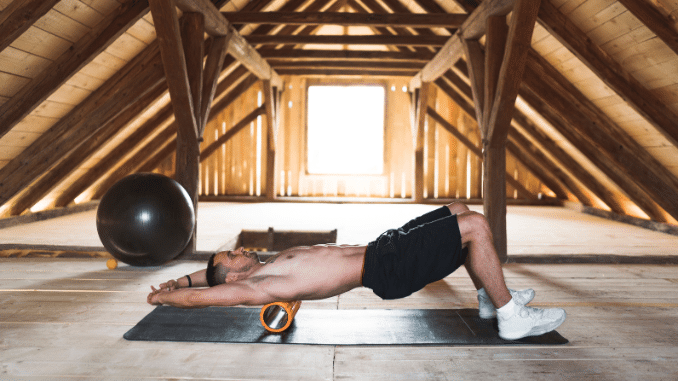
-
Cost-Effective
Foam rollers are relatively inexpensive. Once you have a foam roller, there are no recurring costs associated with its use. Foam Rolling Glutes is a one-time investment, unlike some therapy or recovery tools requiring regular payments.
-
Customizable
Foam rolling can be tailored to target specific muscle groups and areas of tension.
-
Convenience
You can perform Foam Rolling glute exercises at home, in the gym, or virtually anywhere, making it a convenient self-care practice.
-
No Special Equipment Required
All you need is a foam roller, which is readily available and affordable.
-
Self-Administered
You have control over the pressure and intensity, allowing you to tailor the experience to your comfort level.
Effective Foam Roller Exercises For Specific Muscle Groups
1. Quad Rolls
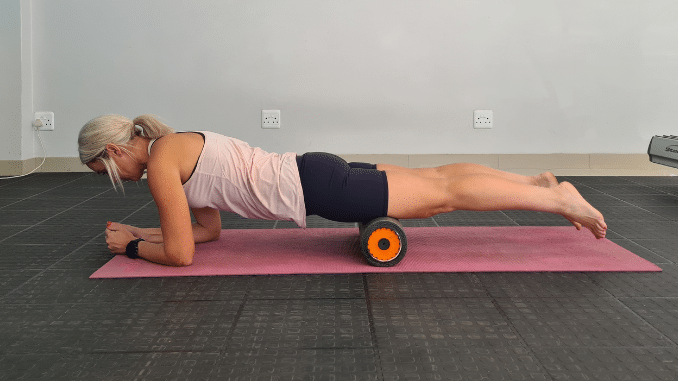
Move into a forearm plank position with the foam roller under your body, just above your knees. Then, maintain good alignment with your head, shoulders, hips, and toes. Contract your core, then run the foam roller from the top of your knees to your hip area and back. Be careful not to roll over your knee joints. lastly, perform the movement for 10 repetitions.
Quads Foam Rolling
The quadriceps, commonly known as the “quads,” consist of four muscles at the front of the thigh. The quads play a critical role in walking, running, climbing, jumping, and any activity that involves bending or straightening the knee. They provide the power to propel your body forward and upward during these movements. Strong quads are essential for maintaining stability in the lower body. They help support the knee joint, preventing it from collapsing or buckling during weight-bearing activities.
-
Variation 1: Inner And Outer Thighs Foam Rolling
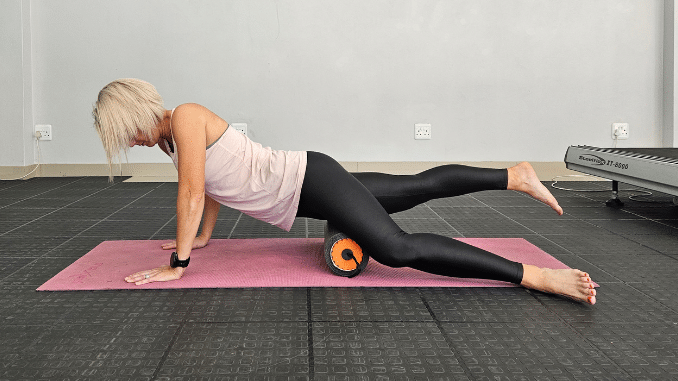
Contract your core, then run the foam roller from just above your knee towards your hip and back. Repeat the movement on the opposite side. Complete 10 repetitions.
Inner And Outer Thighs Foam Rolling
The inner and outer thigh muscles are essential for maintaining stability, proper alignment, balance, and functional movement in daily life. They also play vital roles in various sports and can contribute to injury prevention and overall physical health. Strengthening and conditioning these muscle groups through targeted exercises can benefit a wide range of activities and can help enhance overall functional fitness.
-
Variation 2: IT Band
Begin in a forearm plank position, maintaining good alignment with your head, shoulders, hips, and legs. Then, move to one side and place the foam roller under your hip. Cross your right leg over your left leg and flatten your foot on the floor. Afterward, slowly roll the foam roller from the hip down to just above your knee and back. Perform the movement for 10 repetitions. Lastly, relax and switch to the other side.
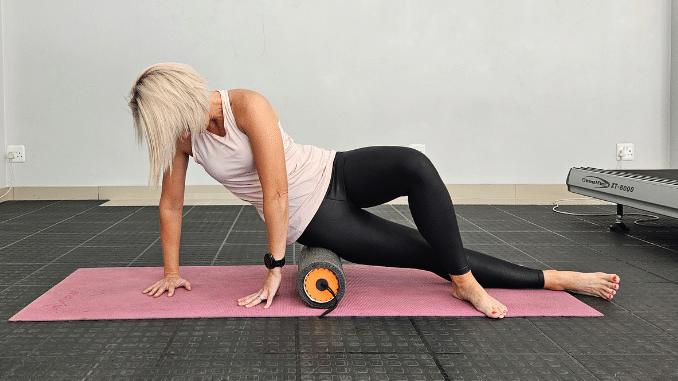 |
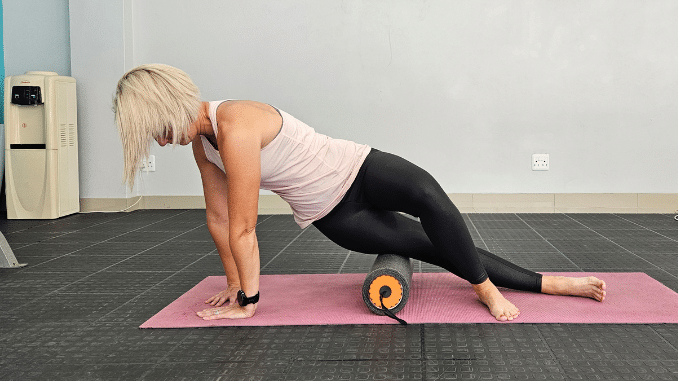 |
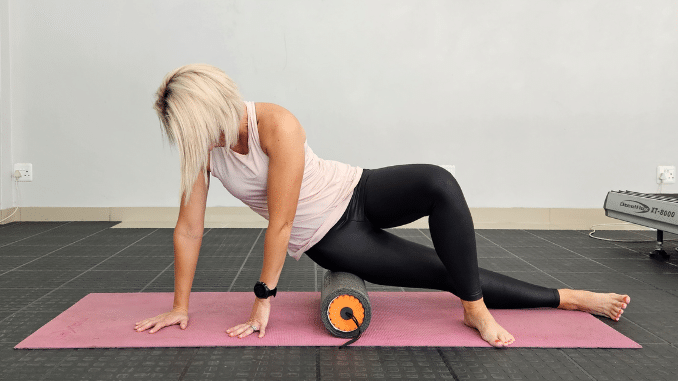 |
The IT band is a vital connective tissue running along the outer thigh from the hip to below the knee. It stabilizes the knee during activities like walking, running, and cycling, preventing injury by aligning the knee properly and reducing side-to-side movement. It also transfers forces from the hip and thigh muscles to the knee and lower leg, which is crucial for efficient movement, running, and jumping. Strong IT bands can prevent knee pain and other related concerns during physical activities.
2. Hamstring Rolls
Sit upright on the floor with your legs straight and your hands at your sides for support. Place the foam roller under your hamstrings. Straighten both arms to lift your seat off the floor, then roll the foam roller from just above your knees to the bottom of your seat and back. Lastly, repeat the movement. Complete 10 repetitions.
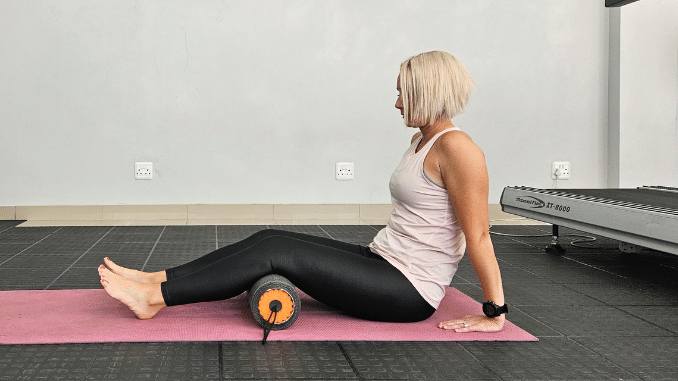 |
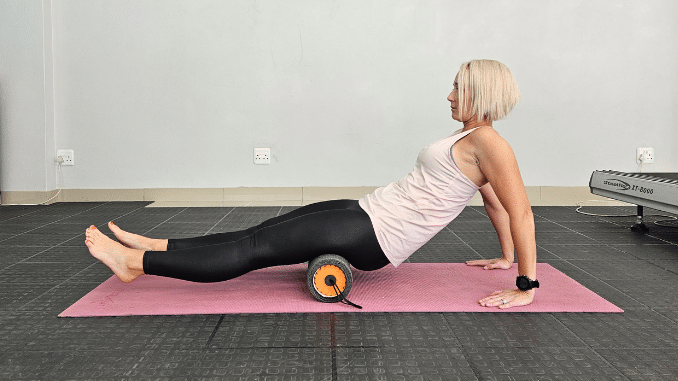 |
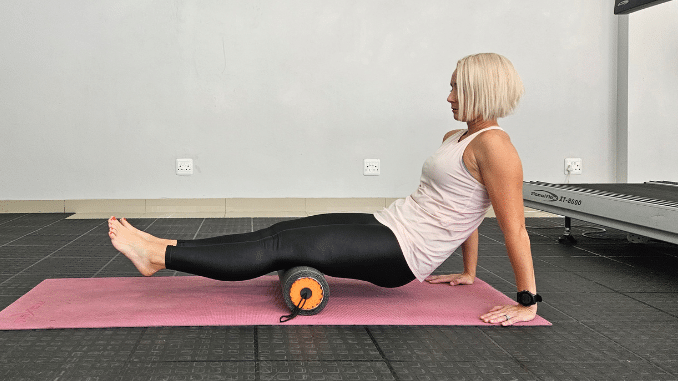 |
Hamstring Foam Rolling
The hamstrings are essential muscles with several key functions. They primarily flex the knee, enabling walking, running, and stair climbing. They improve hip mobility, which is crucial for standing, seated, running, and jumping. Beyond these movements, the hamstrings aid in maintaining balance and proprioception, ensuring stability during various activities and preventing falls and injuries. Strong hamstrings are vital for speed, acceleration, and agility in sports, especially those requiring explosive power like sprinting and jumping.
5. Calf Foam Rolling
Firstly, sit upright on the floor with your legs straight and your hands at your sides for support. Secondly, place the foam roller under your lower calf area. Push from your hands to slightly lift your seat from the floor, then run the roller from the top to the bottom of your lower calf area and back. Lastly, repeat the movement for 10 repetitions.
To put more pressure on a tight calf, stack one foot over the other and roll repeatedly, targeting the tight spot.
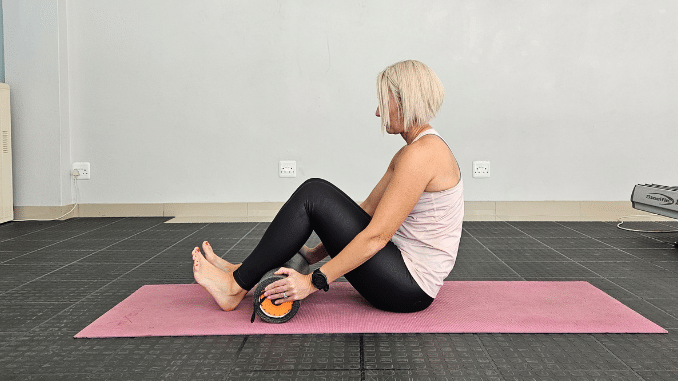 |
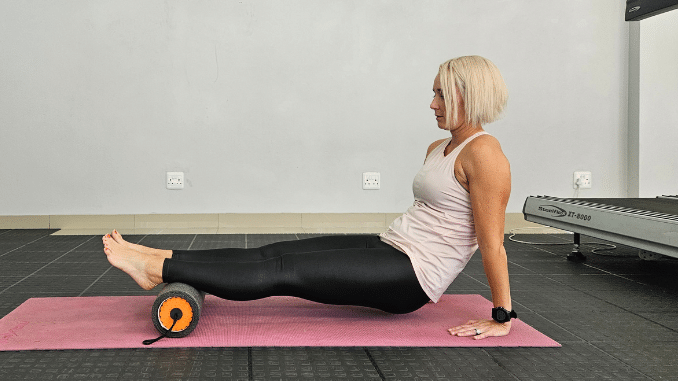 |
 |
Calf Foam Rolling
The calves are important muscles for various activities, from basic mobility to athletic performance. They provide power, stability, and support to the lower limbs and contribute to overall lower limb health and functionality. Also, incorporating calf-specific exercises into your fitness routine can help maintain and strengthen these crucial muscles.
6. Glutes Foam Rolling
Firstly, begin in an upright seated position on top of the foam roller with your knees bent and your feet on the floor. Secondly, turn your body to the left side as you straighten your left leg, resting your left hand behind you for support. Thirdly, roll the foam roller from the bottom of your glute muscles to the top of your pelvis and back. Then, Perform the movement for 10 repetitions. Lastly, relax, return to the starting position, and switch to the other side. Moreover, to put more pressure on the tight glutes, bend your right knee and cross your ankle over to your left knee.
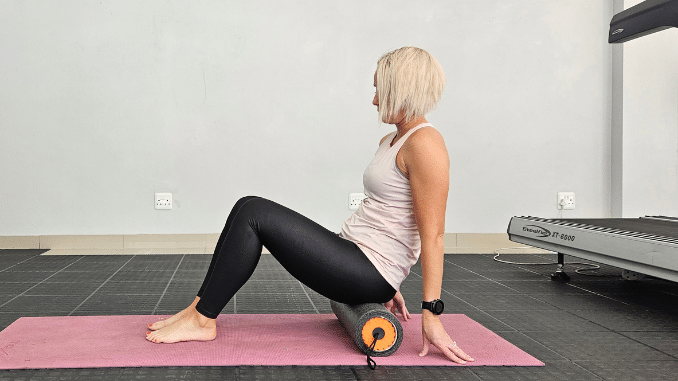 |
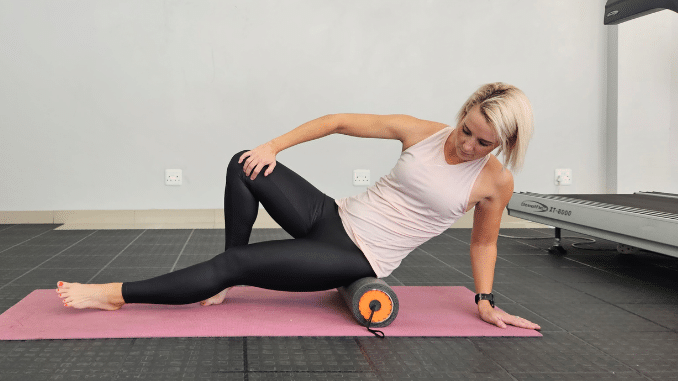 |
Glutes Foam Rolling
The glutes, located in the buttocks, are pivotal muscles in the buttocks. The gluteus maximus powers hip extension, crucial for standing, seated, running, climbing, and jumping. The gluteus medius and minimus handle hip abduction, which is essential for stability during activities like walking, running, and one-legged stances. Strong glutes support proper posture, preventing postural issues and lower back pain. They also improve balance and stability, reducing knee and ankle joint stress and preventing injuries.
7. Back Foam Rolling
Firstly, lie on your back on the floor with your knees bent and your heels on the floor. Secondly, place the foam roller under your upper back, lifting your upper body and maintaining good alignment with your head, shoulders, and hips. Thirdly, Place your hands by your ears to support your neck. Then, run the foam roller from your midback to the base of your neck and back. Lastly, repeat the movement.
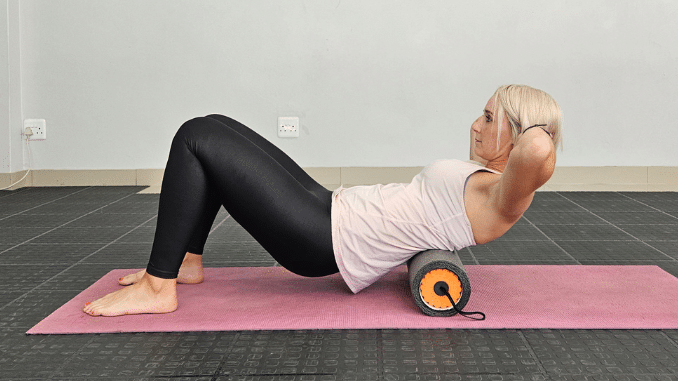 |
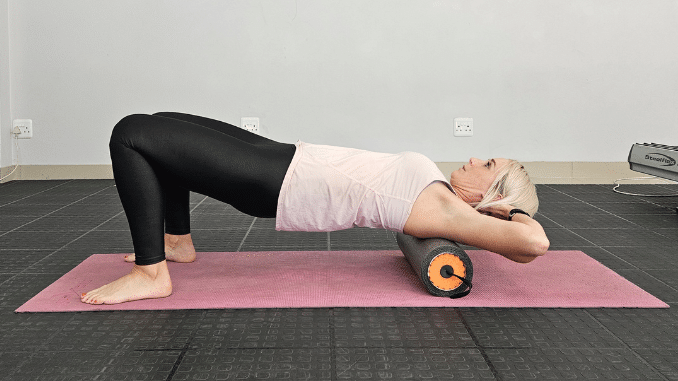 |
Back Foam Rolling
The upper and mid-back play a crucial role in maintaining good posture. These regions of the spine help support the head and shoulders upright. Proper posture is also essential for preventing chronic back and neck pain and reducing the risk of musculoskeletal issues.
8. Lat Foam Rolling
Firstly, lie on your back on the floor with your knees bent and your feet on the floor. Secondly, place the foam roller on the outer part of your back, lifting your upper body and maintaining good alignment with your head, shoulders, and hips. Thirdly, roll the foam roller from your midback up to your armpit and back. Then, repeat the movement. Finally, after several repetitions, repeat the movement on the opposite side.
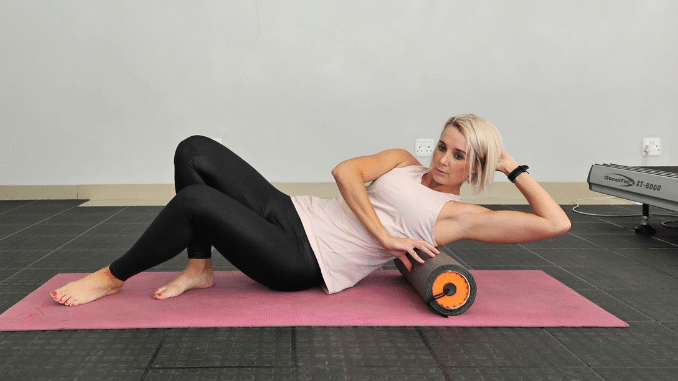 |
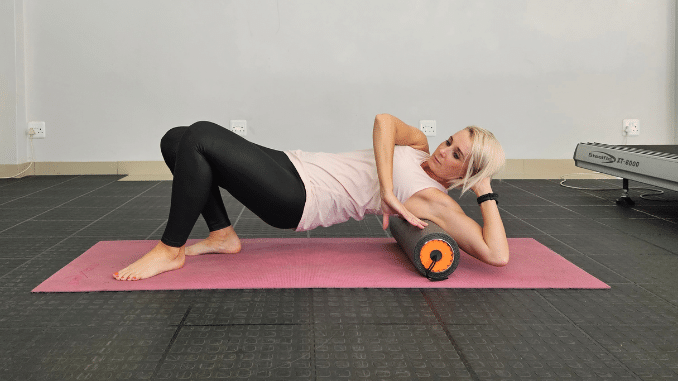 |
Lat Foam Rolling
The latissimus dorsi, commonly called the “lats,” are large muscles on the sides of the back, extending from the upper arm to the lower back. The lats are pivotal for shoulder function, particularly in actions like extension, adduction, and internal rotation, which are crucial for tasks like pulling and lifting. Strong lats enhance posture by supporting the spine and keeping shoulders back, countering poor posture and rounded shoulders. Additionally, they contribute to trunk stability, connecting the upper and lower body, crucial for balance, especially during heavy lifting. Strong lats also reduce the risk of shoulder and upper back injuries by supporting the shoulder joint. Here’s how you can do lat foam rolling:
-
Counter Stretch: Modified Spinal Twist
Begin in an upright sitting position with your legs extended in front of you, maintaining good alignment with your head, shoulders, and hips. Then, tighten your core and twist your upper body to the side, resting your hand on the outside of your hip as you bring your gaze behind your shoulder. Afterward, hold this position for several seconds. Lastly, return to the starting position and repeat the movement on the opposite side.
 | 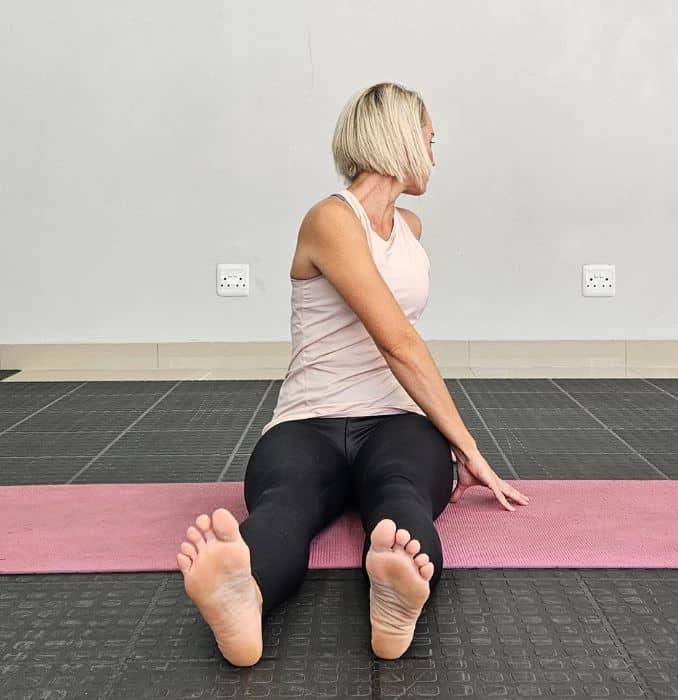 |
Modified Spinal Twist
Conclusion
Foam rolling holds significant importance in the realm of physical well-being and recovery. This self-myofascial release (SMR) technique is valuable for athletes and individuals from all walks of life.
Moreover, by applying pressure to specific muscle groups, foam rolling helps alleviate muscle soreness, break up adhesions, and enhance blood flow, ultimately promoting quicker recovery and reducing the risk of injury. It aids in improving flexibility, allowing for a better range of motion in joints, and contributes to overall muscle health.
Beyond the physical benefits, foam rolling also offers relaxation and stress relief, making it a holistic approach to self-care that addresses both the body and mind. The accessibility, cost-effectiveness, and convenience of foam rolling make it an invaluable addition to any fitness or wellness routine, highlighting its significance in supporting an active and balanced lifestyle.
Check out our Foams Rolling 101 Video series, which is designed to take the guesswork out of any equipment you might require for your various fitness pursuits.

